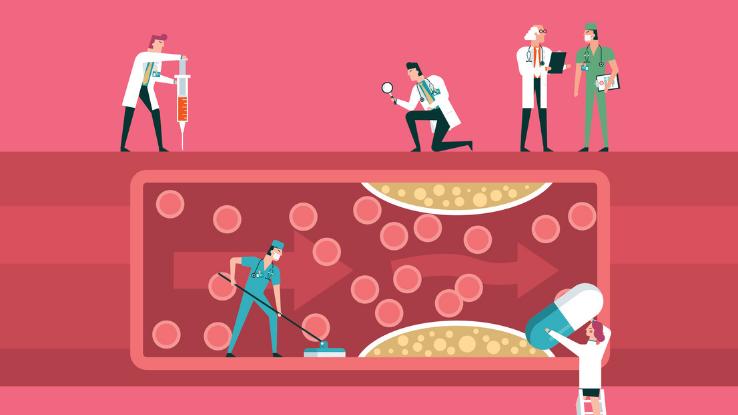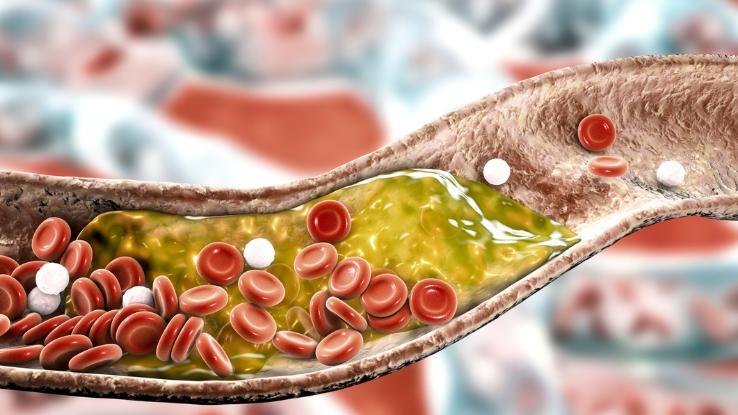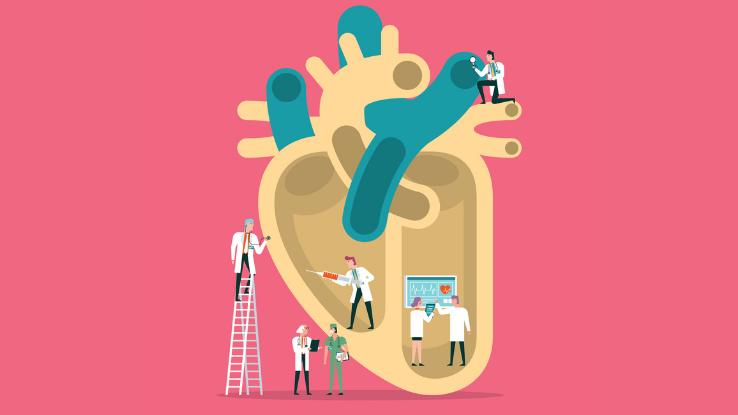Atherosclerosis: The Link Between Hardening Arteries & Cardiovascular Diseases

Atherosclerosis, also known as the hardening of the arteries due to plaques inside your arteries, is a major cause of several health conditions worldwide. Atherosclerosis can affect every middle or large-sized artery and its branches, including the coronary arteries. The resulting cardiovascular diseases are a major cause of mortality worldwide, accounting for one in three deaths in the United States.
Other potential consequences of atherosclerosis include stroke, heart attack or bowel infarction. These secondary conditions usually develop over decades and remain asymptomatic for a long time. Therefore, preventive measures are extremely important. Prevention includes reducing the known risk factors of atherosclerosis through lifestyle measures, lowering blood lipids, adjusting blood pressure and treating diabetes mellitus.
What Is Plaque?
Atherosclerosis comes from the Greek words “athero”, which means paste, and “sclerosis”, which means hard. This name describes a condition in which a plaque adheres to the artery, leading to hardening of the artery or its branches.
Plaque is a sticky substance often made of fat, cholesterol, calcium, and other substances found in the blood. There are two types of plaque, stable and unstable.
- A stable plaque has a thick fibrous cap that is made of smooth muscle cells. Stable plaques recede, remain unchanged or grow slowly over several decades until they cause a stenosis or a vascular occlusion. Those plaques are often asymptomatic or if symptomatic, can be detected and removed before causing severe consequences.
- An unstable plaque is much more dangerous because the cap is much thinner. Therefore, the lid can rupture, allowing the plaque to clot the artery or to travel elsewhere in the body, causing a life-threatening heart attack, stroke, or embolism.
Symptoms Associated With Atherosclerosis
Atherosclerosis often goes without symptoms in the early stages. Symptoms typically only appear once the blockage becomes severe enough to significantly affect blood flow. Often, people don’t know that there is a problem until they have a heart attack or stroke.
If symptoms do appear, they usually reflect the arteries that are affected.
Coronary arteries supply oxygen-rich blood to the heart. If the coronary arteries are affected, symptoms can include:
- Angina (chest pain, but can also be felt in the left arm, neck, back, and jaw)
- Shortness of breath
- Arrhythmias
- Fatigue
- Sleep problems
Carotid arteries supply blood to the brain. Blockages of these arteries can cause a stroke. If the carotid arteries are affected, symptoms can include:
- Sudden weakness
- Paralysis on one or both sides of the body
- Confusion
- Trouble speaking or understanding speech
- Vision problems
- Trouble breathing
- Dizziness
- Loss of balance and coordination
- Loss of consciousness
- Severe headache
Peripheral arteries carry blood to the extremities. Symptoms can include:
- Numbness
- Pain
- Infections
- Cold hands or feet
Renal arteries supply blood to the kidneys. Blockages of these arteries can lead to chronic kidney disease and, over time, loss of kidney function. Symptoms typically don’t appear until the problem is severe and includes:
- Changes in urination
- Loss of appetite
- Nausea
- Tiredness
- Swelling in the hands and feet
- Itchiness or numbness
- Trouble concentrating

Known Causes of Atherosclerosis
There are several causes of atherosclerosis. Some are controllable, but others aren’t. Known causes include:
- Age
- Family history
- High blood pressure
- High LDL cholesterol
- Smoking
- Lack of physical activity
- Obesity
- Poor diet and/or excess calories
- Diabetes
While there is no way to change age or family history, beneficial lifestyle choices such as eating a healthy diet, getting regular physical exercise, and quitting smoking can lower the risk of developing atherosclerosis.
Related Conditions
Atherosclerosis is the leading cause of several conditions, including;
- Coronary Artery Disease (CAD): This causes decreased blood flow to the heart and can lead to heart attack.
- Stroke: Clotting of an artery that allows blood flow to a part of the brain.
- Abdominal Angina: A type of abdominal pain caused by the narrowing of the vessels that supply blood to the intestines.
- Bowel Infarction: Similar to a heart attack but affects the intestines. It is caused by a sudden interruption in blood flow to the intestines.
- Atherosclerosis of the Extremities: 80 to 90% of people with atherosclerosis are also affected in the extremities. This can lead to crampy leg pain and coldness. If severe enough, it can lead to gangrene or tissue necrosis.
- Aortic Aneurysm: This is the bulging of a weak point caused by a blockage in the aorta wall, usually in the thoracic cavity. This bulging weak point can rupture, causing massive internal bleeding and often death.
- Renal Artery Stenosis: The narrowing of the artery that supplies blood to the kidney. This can cause high blood pressure and severely impair kidney function.
How Is It Diagnosed?
A combination of tests can help diagnose atherosclerosis. Diagnostic measures for atherosclerosis relate mostly to identifying patients at high risk of developing severe outcomes. Your doctor will conduct tests based on your symptoms and your medical history.
In some situations, the doctor may need to conduct additional tests to assess what damage on your coronary arteries has already occurred. You may need additional heart tests to determine an effective and personalized treatment plan.
- Health History: A doctor will begin by asking you routine questions related to your personal and family history. Your lifestyle can also reveal whether you are at risk for certain conditions that are caused by atherosclerosis. You may not have started experiencing symptoms, but your doctor will want to screen you as a precautionary measure. Based on your answers, the doctor might choose to conduct additional to diagnose related disorders.
Prevention
Lifestyle changes are used to reduce the risk of developing atherosclerosis or reduce the chances of it worsening. Perhaps the most critical change that someone can make is quitting smoking. Smoking has a host of adverse effects on the body, including making blood stickier and worsening atherosclerosis. Other changes include eating a healthy diet that is low in fat, sugar, and rich in fruits and vegetables.
Moreover, it is advisable to get at least 30 minutes of exercise most days of the week. Exercise doesn’t need to be complicated, and doing simple things like housework or walking is effective.
It should be noted that atherosclerosis is not inevitable. By living a healthy and active lifestyle, people can dramatically reduce the risk of developing this potentially life-threatening problem.
Treatment
Atherosclerosis can be treated in some ways, including lifestyle changes, medication, and procedures, both surgical and non-surgical. A doctor will usually choose the least invasive option for the patient, based on their individual case.
Medications are often used with lifestyle changes to help treat atherosclerosis. The medicines can do some things. A doctor will determine which drugs will be best based on the individual situation. These include:
- Statin medications designed to reduce the amount of cholesterol in the blood
- High blood pressure medications
- Anti-platelet medications such as aspirin or clopidogrel
- Therapy for diabetes mellitus
If these treatment options are not enough, the doctor may recommend surgical or non-surgical procedures to help restore circulation. This could be something as simple as an outpatient stent procedure. A device is inserted into the blood vessel to help restore circulation or as drastic as a bypass procedure. Only a doctor can determine which method will provide the most benefit.

Next Steps
If you want to learn more about the conditions atherosclerosis can cause, you can find more information about hypertension and heartburn elsewhere on our site. Moreover, if you want to know how you can lower your risk of atherosclerosis we have some tips regarding how to do so by lowering your LDL cholesterol naturally.
Resource Links:
- Heart Disease Facts via Centers for Disease Control and Prevention (CDC)
- “Epidemiology of Atherosclerosis and the Potential to Reduce the Global Burden of Atherothrombotic Disease” via Circulation Research
- “Global and regional prevalence, burden, and risk factors for carotid atherosclerosis: a systematic review, meta-analysis, and modeling study” via The Lancet
- “Atherosclerosis” via MSD Manual
- “Atherosclerosis: Process, Indicators, Risk Factors and New Hopes” via International Journal of Preventative Medicine, NCBI, U.S. National Library of Medicine





